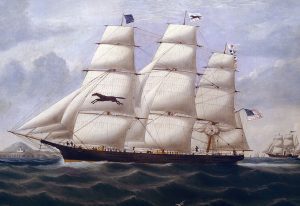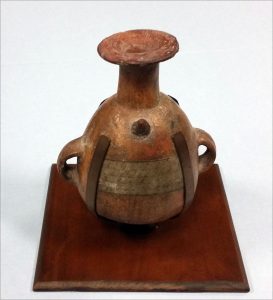As a young man George Blunt Wendell joined a counting house in Portsmouth, New Hampshire as an apprentice. However, in 1847 he commenced his seafaring career as a cabin boy and 3 years later became first mate on a voyage. Wendell’s first command was in 1853 and by 1860 he commanded the clipper GALATEA. It was often that a ship master was found to be a thorough seaman and smart navigator, but a poor merchant. Wendell however, used his mercantile knowledge obtained in the counting house to good advantage, and his voyages usually proved profitable for the vessel’s owners and himself.

Some of his last voyages were involved in carrying cargoes of guano from the Chincha Islands on the coast of Peru. Hundreds of American ships were among the multi-national fleets that hauled guano in the mid-19th century. Sea-bird guano was a valuable commodity, especially as a fertilizer, and the Chincha Islands near Callao, Peru were the best source. In a collection of Wendell’s papers in the G.W. Blunt White Library, given to the Museum by Wendell’s son, there is a note from October of 1860 to Capt. Wendell from a Commodore Jones. While it is unclear as to who Jones was, there is speculation that he was part of the Peruvian navy and involved in administration of the port at the Chinchas by the tone of his note. It states: “Dear Sir, I send you by the bearer two small jugs taken out from 300 feet under the guano.” He then follows it with “You must not fire any more guns, as you did last night. It is contrary to the orders of the port and also a fine of $25 for each gun. Yours truly, F.D. Jones.”

The pre-Columbian Incan vessel seen here, an aribalo, was a very common long-necked vessel used for carrying liquids, among other uses, and was one of the subjects of Jones’ letter to Captain Wendell. Incas were known to use guano as a fertilizer in their terraced fields, so it is not unusual that this particular artifact might be left behind on one of the islands. Unearthing such an object from beneath tons of such caustic waste centuries later was a side note to the brutal endeavor of mining there. Most laborers in the 19th century were shipped to the islands and coerced by one manner or other to work there, many until they succumbed from the conditions. How he came by it and why Commodore Jones thought to give this particular object to Captain Wendell is unknown, but it is now a unique object within the collection of Mystic Seaport. Other objects, manuscripts and images from Mystic Seaport have been instrumental in publications and exhibits about this odoriferous subject. Current exhibits on guano include the Smithsonian’s The Norie Atlas and the Guano Trade and one section of the new exhibit Sea Change in the brand new Thompson Exhibition Building at Mystic Seaport.